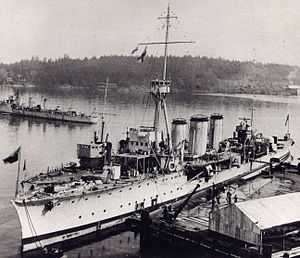HMS Aurora (1913)
 HMCS Aurora in 1921. | |
| Career (United Kingdom) | |
|---|---|
| Name: | Aurora |
| Operator: | Royal Navy |
| Builder: | Devonport Dockyard |
| Laid down: | 24 October 1912 |
| Launched: | 30 September 1913 |
| Commissioned: | September 1914 |
| Decommissioned: | 1918 |
| Fate: | Sold to Canada 1920 |
| Career (Canada) | |
| Name: | Aurora |
| Operator: | Royal Canadian Navy |
| Commissioned: | 1 November 1920 |
| Decommissioned: | Paid off in 1921 and disarmed in 1922 |
| Fate: | Sold for scrap, August 1927 |
| General characteristics | |
| Class and type: | Arethusa class light cruiser |
| Displacement: | 3,500 tons |
| Length: | 436 ft (133 m) overall |
| Beam: | 39 ft (12 m) |
| Draught: | 13.5 ft (4.1 m) |
| Propulsion: | Parsons turbines Eight Yarrow boilers 40,000 hp |
| Speed: | 28.5 knots (53 km/h) |
| Range: | carried 482 tons (810 tons maximum) of fuel oil |
| Complement: | 318 |
| Armament: | 2 × BL 6-inch (152.4 mm) Mk XII guns 6 × QF 4-inch Mk V guns |
HMS Aurora was an Arethusa-class light cruiser that saw service in World War I with the Royal Navy and in the Interwar Period with the Royal Canadian Navy.
Construction started on 24 October 1912 on Aurora and she was launched on 30 September 1913 at Devonport Dockyard. She was commissioned into the Royal Navy in September 1914.
Service history
Royal Navy
Aurora saw service as part of the Grand Fleet from 1914 to 1915, as leader of the 1st Destroyer Flotilla. In 1915, she was assigned as leader of the 10th Destroyer Flotilla of the Harwich Force, guarding the eastern approaches to the English Channel.[1]
_mines_closeup_WWI_IWM_SP_001196.jpg)
Her experienced crew and durability made her a natural choice as a flagship during many offensive operations throughout the course of World War I. She was the first Royal Navy warship in action at the Battle of Dogger Bank. In August 1915 she took part in sinking of the German raider Meteor. In 1918 she was again reassigned, to the 7th Light Cruiser Squadron of the Grand Fleet. Aurora was one of the ships present at the surrender of the German High Seas Fleet in November 1918.[1]
Between 1918 and 1920, Aurora was decommissioned to relieve financial pressures of the Home Fleet by the Admiralty. Her manning was reduced to a custodian crew and the relieved personnel were sent to other units.
Royal Canadian Navy
On 25 March 1920, the Canadian government accepted a British offer of one light cruiser and two destroyers to replace the two decrepit cruisers currently owned by Canada.[2] Originally a Bristol class cruiser was offered, however they ran on coal and eventually the Canadian government negotiated for an oil-burning cruiser.[3] In 1920 she was re-activated to outfit her for transfer to the Royal Canadian Navy. The cost of fitting out the cruiser for service in the northern Atlantic cost $10,495, exclusive of machinery and a refrigeration plant.[4]
The Royal Canadian Navy commissioned her on 1 November 1920. She sailed shortly afterward from the United Kingdom for Halifax, Nova Scotia, arriving on 21 December with two ex-Royal Navy destroyers that had also been transferred.
After a minimal time in port at HMC Dockyard, the three ships set out for a training cruise via the Caribbean to Esquimalt, British Columbia. The cruise masked the secret mission of carrying secret documents from the Admiralty to British consulates throughout Central and North America. While on the cruise, the squadron was ordered to Puntarenas, Costa Rica, where their presence was used to strengthen the Canadian government position in negotiations over oil concessions.[4] Aurora returned to Halifax on 30 July 1921 via the same route.
In August 1921, drastic budget cuts resulted in the decommissioning of Aurora.[5] She was immediately paid off, and in 1922 she was disarmed.[6] Her weapons were placed ashore in training facilities and on other active ships. Her crew was reduced to non-manned, much of her up-to-date equipment was salvaged for use in other Canadian warships.[6] The Aurora 's hulk was left alongside a jetty at the Canadian naval base in Halifax until 1927 when her deterioration resulted in city officials demanding the navy move her. The Royal Canadian Navy immediately sold her for scrap in August 1927 to A.A. Lasseque of Sorel, Quebec, and she was broken up.[7]
Commanding officers
References
- Footnotes
- Sources
- Colledge, J. J.; Warlow, Ben (2006) [1969]. Ships of the Royal Navy: The Complete Record of all Fighting Ships of the Royal Navy (Rev. ed.). London: Chatham Publishing. ISBN 978-1-86176-281-8. OCLC 67375475.
- Jane's Fighting Ships of World War One (1919), Jane's Publishing Company
- Johnston, William; Rawling, William G.P; Gimblett, Richard; and MacFarlane, John. (2010) The Seabound Coast: The Official History of the Royal Canadian Navy, 1867-1939. Volume 1; Toronto: Dundurn Press. ISBN 978-1-55488-908-2
- Macpherson, Ken; Barrie, Ron (2002). Warships of Canada's Naval Forces 1910-2002 (3 ed.). St. Catharines: Vanwell Publishing Ltd. ISBN 1-55125-072-1.
- Ships of the Arethusa class
External links
| Wikimedia Commons has media related to HMS Aurora (ship, 1914). |
| ||||||||||||||||||